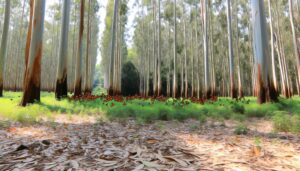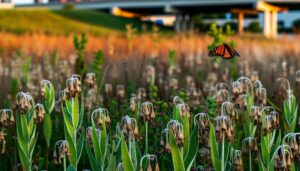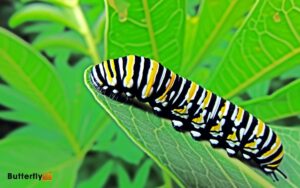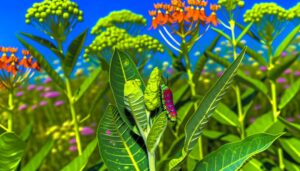What Do Monarch Butterflies Migrate to Mexico For?
Monarch butterflies commence their migration to Mexico in late summer to early autumn, triggered by critical environmental cues. Declining temperatures below 18°C and shortened daylight hours under 12 hours catalyze their migration.
A reduction in milkweed and nectar sources are pivotal in initiating their journey. Wind patterns and atmospheric pressure variations further aid their southward travel.
This meticulously timed migration is essential for their survival and reproductive success, synchronizing their departure from North American breeding grounds. Understanding these environmental triggers and migratory patterns is key to appreciating the fascinating life cycle of Monarch butterflies.

Key Takeaways
- Monarch migration to Mexico typically begins in late summer to early autumn.
- Declining temperatures below 12°C and reduced daylight hours trigger migration.
- Migration is catalyzed by the depletion of milkweed and nectar sources.
- Favorable wind patterns and atmospheric pressure variations aid the migration.
Environmental Triggers
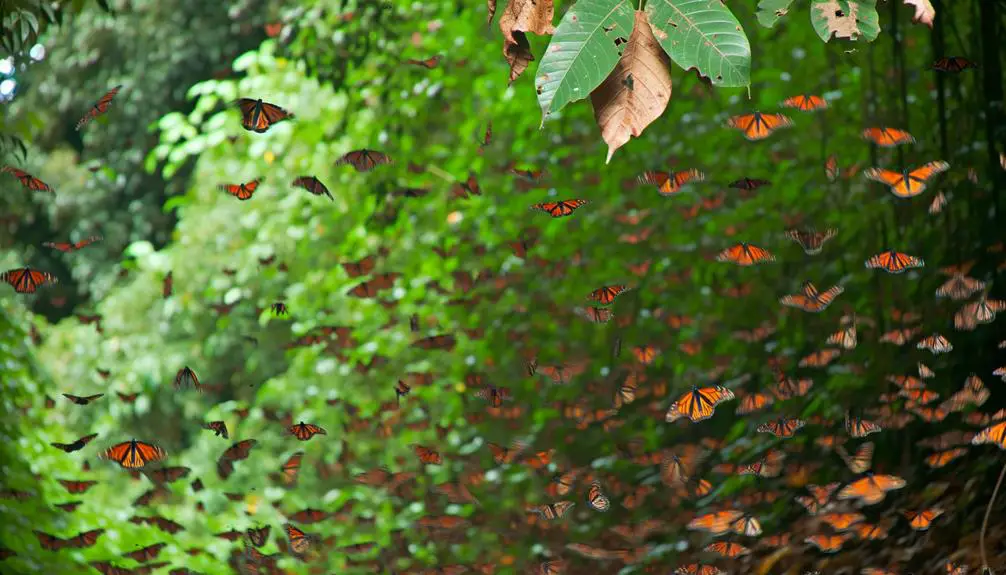
Environmental triggers that initiate the migration of Monarch butterflies include changes in temperature, photoperiod, and the availability of food sources.
Monarchs exhibit a finely tuned response to these factors, with declining temperatures and shorter daylight hours signaling the need to commence their southward journey.
Studies indicate that temperatures falling below 12°C disrupt metabolic processes, triggering migratory behavior.
Additionally, a reduction in photoperiod to approximately 12 hours per day serves as a critical cue.
The depletion of milkweed and nectar sources further compels Monarchs to seek habitats with ample resources.
These data-driven observations underscore the intricate interplay between environmental variables and biological imperatives, highlighting the Monarchs' remarkable adaptability and the freedom inherent in their migratory patterns.
Seasonal Changes
As Monarch butterflies respond to environmental triggers, seasonal changes play a pivotal role in shaping their migratory patterns, with specific climatic conditions and resource availability influencing their movement.
Research indicates that the onset of cooler temperatures and declining nectar sources in North America catalyze their southward journey.
Observational data reveal that Monarchs begin migrating in late summer to early autumn, when milkweed and flowering plants, essential for sustenance, wane considerably.
These biotic and abiotic factors converge, prompting the butterflies to traverse thousands of kilometers to Mexico.
Additionally, atmospheric pressure variations and wind patterns further facilitate their migration, ensuring the Monarchs' successful arrival in their overwintering sites.
Consequently, seasonal changes are integral to their survival and reproductive success.
Day Length and Temperature

Day length and temperature are critical factors in regulating the migratory behavior of Monarch butterflies, with empirical studies demonstrating that shortened daylight hours and cooler temperatures serve as key environmental cues for initiating their southward migration.
Observational data indicate that a decrease in photoperiod below 12 hours triggers the physiological changes necessary for migration. Concurrently, temperature drops below 18°C accelerate metabolic shifts conducive to long-distance travel.
These environmental signals synchronize the departure of millions of Monarchs from North American breeding grounds to overwintering sites in Mexico. Research data corroborate that this intricate interplay between abiotic factors guarantees the timely and coordinated migration, critical for the survival of the species given the narrow time window for ideal conditions.
Monarch Lifecycle
The Monarch butterfly (Danaus plexippus) undergoes a complex lifecycle comprising four distinct stages: egg, larva (caterpillar), pupa (chrysalis), and adult. This metamorphic process is regulated by both genetic programming and environmental cues, ensuring survival and continuation of the species. The lifecycle duration varies, with the egg stage lasting approximately 3-5 days, the larval stage 10-14 days, the pupal stage 10-14 days, and the adult stage ranging from 2-5 weeks, except for the migratory generation, which can live up to 8 months.
| Lifecycle Stage | Duration (Days/Weeks) |
|---|---|
| Egg | 3-5 days |
| Larva (Caterpillar) | 10-14 days |
| Pupa (Chrysalis) | 10-14 days |
| Adult | 2-5 weeks (up to 8 months) |
Understanding these stages is vital for conservation efforts and habitat management.
Migration Routes
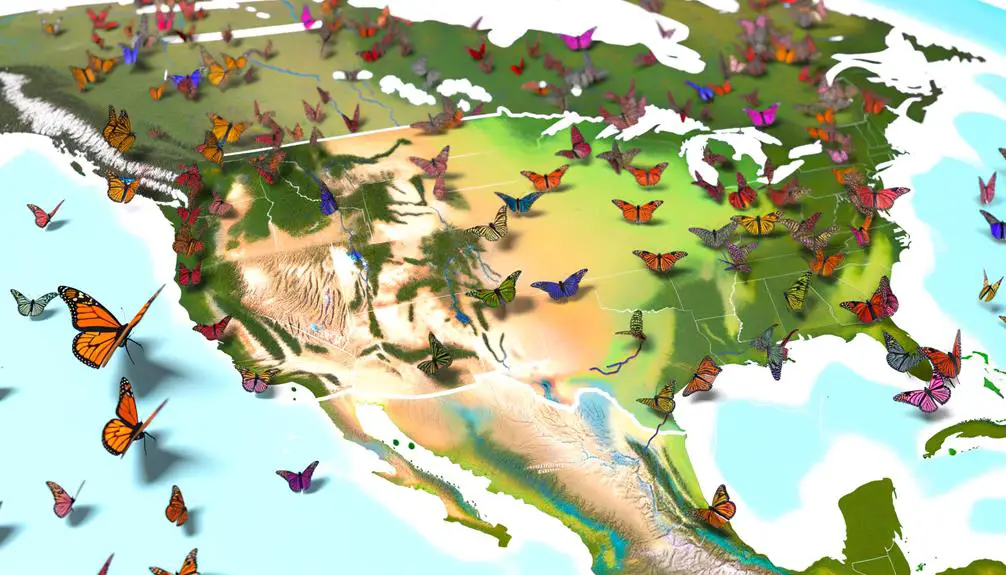
Monarch butterflies exhibit remarkable navigational precision, primarily following two major flight paths: the eastern route to central Mexico and the western route to coastal California.
Research indicates that these routes are consistently used due to favorable wind patterns and the availability of nectar-rich plants.
Key rest stops, such as Point Pelee in Canada and the Sierra Madre Mountains, provide essential resources for refueling and protection during their extensive migratory journey.
Primary Flight Paths
Primary flight paths of migratory monarch butterflies are characterized by distinct, data-driven routes that span from North America to central Mexico. Monarchs utilize two primary corridors: the Eastern and Western migratory routes.
The Eastern route, extensively documented via tagging programs, commences from southern Canada and the northeastern United States, converging through the central United States towards Texas.
The Western route, less populous, originates from the western United States, maneuvering towards coastal California before redirecting southeast.
These routes are heavily influenced by environmental cues such as temperature gradients and wind patterns.
Utilizing geospatial tracking and isotopic analysis, researchers have delineated these paths with remarkable precision, illustrating the monarch's extraordinary navigational capabilities and resilience against climatic adversities.
Key Rest Stops
Amidst their arduous journey, migratory monarch butterflies rely on key rest stops, which serve as critical habitats providing necessary resources for refueling and shelter. These sanctuaries, often located in central flyways such as the Central Texas Monarch Waystation Network, are essential for sustaining the butterflies' energy levels.
Data indicate that milkweed (Asclepias spp.) availability at these stops is paramount, offering indispensable nectar and larval host plants. Observational studies show that monarchs also utilize forested areas for protection against adverse weather.
The strategic placement of these rest stops guarantees the connectivity of the migration route, thereby facilitating the journey to overwintering sites in Mexico. Conservation efforts focus on preserving these critical habitats to maintain the monarch population's resilience.
Conservation Efforts
Conservation efforts for monarch butterflies focus primarily on habitat preservation strategies and combating climate change.
Habitat preservation involves protecting and restoring milkweed plants, critical for monarch reproduction, as indicated by studies showing a 90% decline in their population over the past two decades.
Concurrently, mitigating climate change is essential, as evidenced by research linking temperature fluctuations to disrupted migratory patterns and reduced survival rates.
Habitat Preservation Strategies
Implementing effective habitat preservation strategies is critical for ensuring the survival of monarch butterflies, whose populations have seen dramatic declines due to habitat loss, climate change, and pesticide use.
One pivotal approach involves the restoration and expansion of milkweed habitats, the primary larval food source. Data from the Monarch Joint Venture indicates that planting native milkweed can considerably enhance larval survival rates.
Additionally, protecting overwintering sites in Mexico, such as the Monarch Butterfly Biosphere Reserve, is essential. Research shows that deforestation in these areas has reduced suitable habitats by over 20% in the past decade. To combat this loss, conservation efforts must focus on reforestation and sustainable land management within the Monarch Butterfly Biosphere Reserve. Local communities play a crucial role in these initiatives, as their participation ensures long-term protection of the habitat. Strengthening policies against illegal logging will also help preserve the delicate ecosystem that monarch butterflies rely on each winter.
Conservationists advocate for policy-driven land management practices to mitigate these impacts, thereby promoting sustainable monarch migration patterns and population stability.
Combating Climate Change
Addressing the broader impacts of climate change on monarch butterflies, recent studies have demonstrated that rising temperatures and altered precipitation patterns are greatly disrupting their migratory cycles and breeding habitats.
Specifically, data from the Monarch Joint Venture indicate a 90% decline in Eastern monarch populations over the last two decades. Altered climate conditions are causing asynchronous plant phenology, where milkweed and nectar plants essential for monarchs are not available when needed.
Conservation efforts must focus on mitigating climate change impacts through habitat restoration, planting climate-resilient milkweed species, and reducing greenhouse gas emissions.
Additionally, policies encouraging organic farming and reducing pesticide usage can bolster monarch resilience.
These data-driven strategies are pivotal for ensuring the monarch butterfly's survival and migration continuity.
Conclusion
The juxtaposition of environmental triggers and seasonal changes illuminates the complexity behind monarch butterflies' migration to Mexico. Influences such as day length and temperature intricately interplay with the monarch lifecycle, dictating precise migration routes.
Conservation efforts, fueled by detailed observations and data-driven strategies, underscore the urgency of protecting these migratory patterns.
Understanding these multifaceted factors is paramount for ensuring the survival of this iconic species, whose journey epitomizes the delicate balance within ecological systems.


